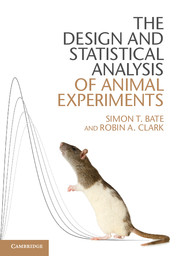2 - Statistical concepts
Published online by Cambridge University Press: 05 March 2014
Summary
Before we describe the experimental designs and statistical analyses that may be of use to the researcher, a few fundamental concepts are introduced. While many researchers are familiar with these concepts, they are the foundation for the arguments that follow and hence are considered first.
Decision-making: the signal-to- noise ratio
Arguably the primary role of the statistical analysis of an animal experiment is to allow the scientist to draw reliable conclusions from the results obtained. Statistics provides the decision-maker with a framework for achieving this. Importantly it also quantifies the confidence that should be placed in that decision.
Example 2.1: Plasma glucose level
Consider the following two experiments, designed to assess the effect of two treatments A and B, on reducing plasma glucose levels in diabetic mice. Treatment A was tested in experiment 1, treatment B in experiment 2. Both studies also included a control group to allow a test of the treatment effect. The plasma glucose level of the two control groups was around 280 mg/dL. Animals dosed with treatment A had an average plasma glucose level of 227 mg/dL whereas those dosed with treatment B had an average of 185 mg/dL. Without any further information it appears that treatment B was more effective at decreasing plasma glucose level. A scatterplot of the four averages is presented in Figure 2.1.
But was this conclusion valid? It is always difficult to compare results across experiments, even if the control groups appear to be similar. Other effects, unique to each experiment, may be influencing the results. We shall comment further on this later, where it will be shown that other experimental designs may be more appropriate.
Assume that different researchers carried out the two experiments; a plot of the individual results is presented in Figure 2.2.
- Type
- Chapter
- Information
- Publisher: Cambridge University PressPrint publication year: 2014

